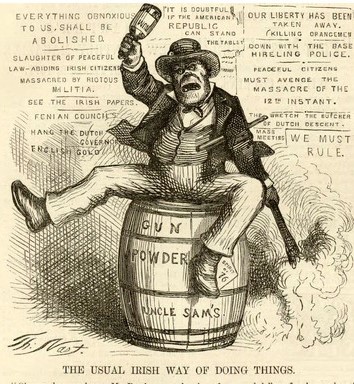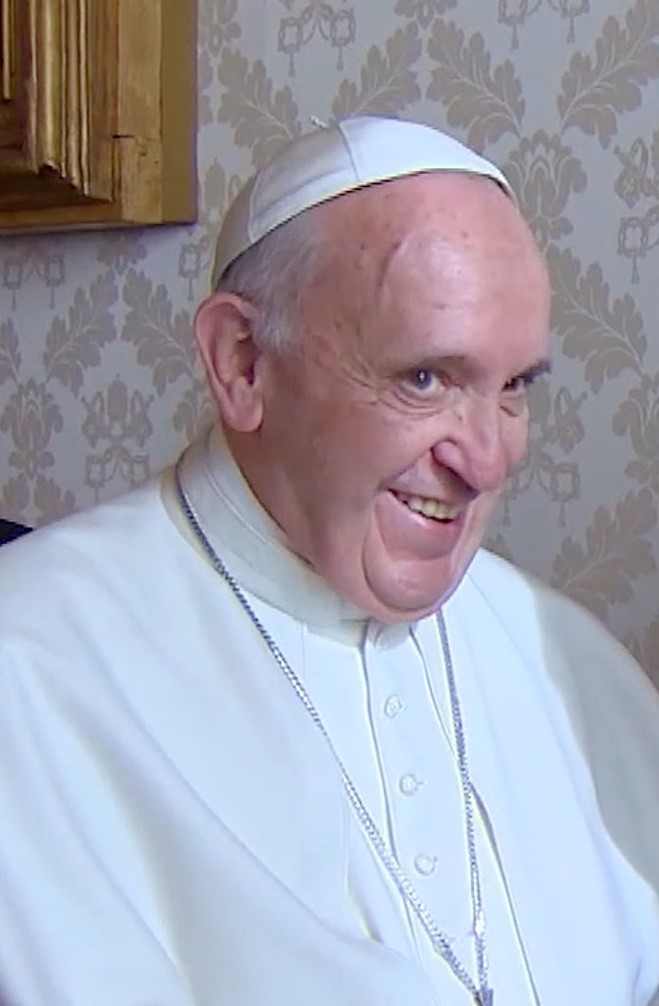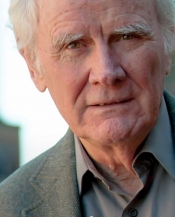.
.From The Remnant
By Jesse Russell, Ph.D.
“How much do they pay you to turn your back on your own people?”
James Carroll knows where the money is.
The former Paulist priest has a made a career of attacking the Catholic faith—his most famous work, Constantine’s Sword, is a cartoonish rant against the Church’s majesty and power, worthy of the cheapest fundamentalist tract or the most poorly researched Game of Thrones-tier Atheist Reddit post.
For his work in betraying his faith as well as his own Irish Catholic heritage, the former “Fr.” James Carroll has been lavished with money, awards, and a visible platform from which to rage against the Church.
His most recent thirty pieces of silver were given for an attack on the institution of the priesthood in the pages of The Atlantic Monthly.
In the bluntly titled, “Abolish the Priesthood,” Carroll outplays the Catholic left by placing the blame for endemic homosexual rape by Catholic priests not on clericalism, but on the nature of the Catholic priesthood itself.
Carroll’s piece is drenched in the crocodile tears typical of so many ethnic Catholic sons and daughters of immigrants who have made a fortune airing the dirty laundry of both their ethno-religious communities as well as, in many cases, their own personal experiences growing up in “strict” Irish, Italian, Polish, or other ethnic Catholic families.

Ignoring the fact that the vast majority of clerical sexual abuse cases are instances of homosexual rape of post-pubescent boys, Carroll blames the crisis on “pedophilia” and creates a delusionary scenario in which American and European media (Carroll himself has worked for the Boston Globe) and governmental agencies (themselves under pressure from bitterly anti-Catholic lobbying groups) heroically are administering justice upon the corrupt and wicked Roman Catholic Church.
 An anti-Catholic cartoon shows the pope's nuncio Archbishop Francesco Satolli in 1894, casting his controlling shadow across the U.S.
An anti-Catholic cartoon shows the pope's nuncio Archbishop Francesco Satolli in 1894, casting his controlling shadow across the U.S.
At the same time in his piece, Carroll does raise a number of correct and laudatory criticisms of both Pope Francis and the contemporary modernist Church.
James Carroll is entirely correct to mock the attempt by the USCCB to clean their own house as being “like putting Mafia chieftains in charge of a crime commission.”
Carroll is further very likely correct in assuming that when Pope Francis claimed to have never heard of the cases of child abuse in Ireland at the Magdalene Laundries, he probably was lying.
In fact, Francis’s duplicity and ineptitude was so strong as to make Carroll, someone who has made his career as being a “former Catholic priest,” abandon the practice of his faith—something he is more than happy to share with the readers of the Atlantic along with a very solemn photo of Carroll praying.
This personal confession, however, is given merely to excite the emotions of the reader and to prepare for Carroll’s full-throated attack on traditional Catholicism.
For Carroll, the Church is simply an NGO; what he calls “the largest nongovernmental organization on the planet…,” which provides for material needs around the world.
Carroll, like many Old Liberals (he says, at one point, that he was “very much part of the Vatican II generation”) had hoped Vatican II would detonate 2,000 years of Catholic tradition and replace it with this enormous NGO. However, things did not turn out as James Carroll and the other Old Liberals had hoped, and the terrible reactionary traditional Church, which Carroll explicitly associates with Nazism (the central thesis of his Constantine’s Sword), still lived on.
In fact, the bulk of “Abolish the Priesthood” is a rehash of not only Constantine’s Sword, but every tired modernist, “Gather Us In”-level, Old Liberal trope in the book.
In Carroll’s version of Church history, the early Church was a group of fun loving hippies who simply wanted to take care of the poor and get along with everyone. However, the wicked authoritarian Romans impressed their rigid, patriarchal culture onto the Church.
The real teaching of Christ was of free love; however, uptight Church Fathers like St. Augustine introduced the repressive ideas of chastity and celibacy.
The original Church was as egalitarian as a hippy commune, but the nasty Middle Ages introduced a hierarchical structure.
Pope Francis, Carroll had hoped, was going to continue the “Great Work” of Vatican II and dismantle the Church’s ancient traditions and teachings in order to bring about a new tolerant and humanistic Church.
Carroll’s gushing praise of what he thought Pope Francis is worth quoting in full:
Pope Francis seemed to me, in the beginning, like a rescuer. I think of his surprisingly simple first words from the balcony of Saint Peter’s right after his election: “Fratelli e sorelle, buonasera!” He had no use for the red-velvet slippers or the papal palace, and made a point of chastising rank-conscious prelates. He cradled and kissed the blistering feet of a Muslim inmate in a Roman prison and made a pilgrimage to the U.S.-Mexico border. He opened the door to Cuba and shut down the ancient Catholic impulse to convert the Jews. He has argued that religion is not a zero-sum enterprise in which the truth of one faith comes at the expense of the truth of others. (“Proselytism,” he told a journalist, “is solemn nonsense.”) He issued an encyclical urging care for the global environment, and gave that effort a theological underpinning.
With the exception of the first sentence and the praise, Carroll’s accurate description of Francis’s disastrous attempt to overturn the Church could easily be found in the pages of The Remnant.
Carroll then attempts to present a slight mitigation of his critique of Francis by noting that a terrible reactionary element in the Church represented by Archbishop Viganò, Cardinal Burke, Pope Benedict XVI, and even Steve Bannon have attempted to stonewall Francis’s reforms—although, Carroll does seem to suggest that some of Viganò’s critique’s of Pope Francis’s handling of abuse are sound.
However, despite his attempts to completely eradicate Catholic tradition, Pope Francis is, for Carroll, simply a company man, who responded to the Cardinal McCarrick affair with “silence, denial, and a business-as-usual summoning of crimson-robed men to Rome.”
Where’s the lie, though?
However, instead of purging of the corrupt prelates from the Church, James Carroll’s ultimate solution to the problem of the corruption of the Church is to destroy the priesthood as an institution.
Carroll’s attack on the priesthood is weirdly full of his personal anecdotes and feelings of torment and guilt about the failings of (perhaps his own) priesthood—Carroll interestingly admits that he worked with the notorious predator Fr. Paul Shanley at one point of a life, something, which Carroll says “haunts” him to this very day.
His solution is a sort of egalitarian New Age hippy community that is, again, worth quoting in full:
Replacing the diseased model of the Church with something healthy may involve, for a time, intentional absence from services or life on the margins—less in the pews than in the rearmost shadows. But it will always involve deliberate performance of the works of mercy: feeding the hungry, caring for the poor, visiting the sick, striving for justice. These can be today’s chosen forms of the faith. It will involve, for many, unauthorized expressions of prayer and worship—egalitarian, authentic, ecumenical; having nothing to do with diocesan borders, parish boundaries, or the sacrament of holy orders. That may be especially true in so-called intentional communities that lift up the leadership of women. These already exist, everywhere. No matter who presides at whatever form the altar takes, such adaptations of Eucharistic observance return to the theological essence of the sacrament.
These sort of statements have been heard ad nauseam by Catholics even before the Second Vatican Council. However, there is an eerie cast to them in the twenty first century.
 As we speak, the Church is being drained of her wealth and property by a never ending series of lawsuits; she is further being investigated by several state district attorneys, again, under pressure from a few anti-Christian lobbying groups; and her pews have nearly entirely emptied by sixty years of Novus Ordo liturgies and modernist teaching.
As we speak, the Church is being drained of her wealth and property by a never ending series of lawsuits; she is further being investigated by several state district attorneys, again, under pressure from a few anti-Christian lobbying groups; and her pews have nearly entirely emptied by sixty years of Novus Ordo liturgies and modernist teaching.
While faithful Catholics might rejoice that corrupt liberal and neoconservative leadership in the Church will soon face secular justice, those agitating these attacks on the Church do not have the best interest of Catholics in mind, and they, like James Carroll, desire to destroy, not cleanse the Catholic Church.
As another curious note, James Carroll seems to pull a “John Podesta’s Catholic Spring,” calling for a “#ChurchResist” campaign on social media.
One wonders if James Carroll was put up to writing “Abolish the Priesthood” by one of our old friends in the global elite.
If your author were a betting man, he would guess that James Carroll was not the only active force behind “Abolish the Priesthood.”
There are other forces at work here that are attacking the Church from virtually every angle.
As Catholics we must be continue to fight a political and spiritual war that is about ready to get white hot.

No comments:
Post a Comment
Comments are subject to deletion if they are not germane. I have no problem with a bit of colourful language, but blasphemy or depraved profanity will not be allowed. Attacks on the Catholic Faith will not be tolerated. Comments will be deleted that are republican (Yanks! Note the lower case 'r'!), attacks on the legitimacy of Pope Francis as the Vicar of Christ (I know he's a material heretic and a Protector of Perverts, and I definitely want him gone yesterday! However, he is Pope, and I pray for him every day.), the legitimacy of the House of Windsor or of the claims of the Elder Line of the House of France, or attacks on the legitimacy of any of the currently ruling Houses of Europe.